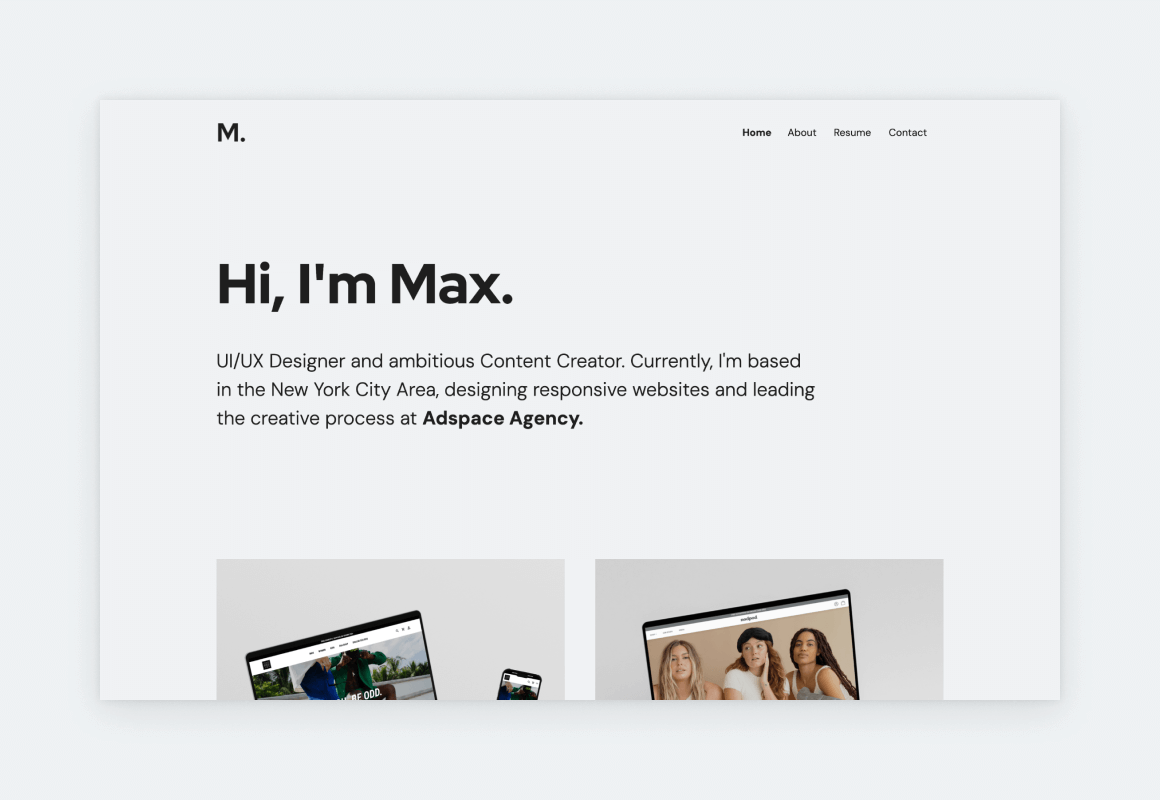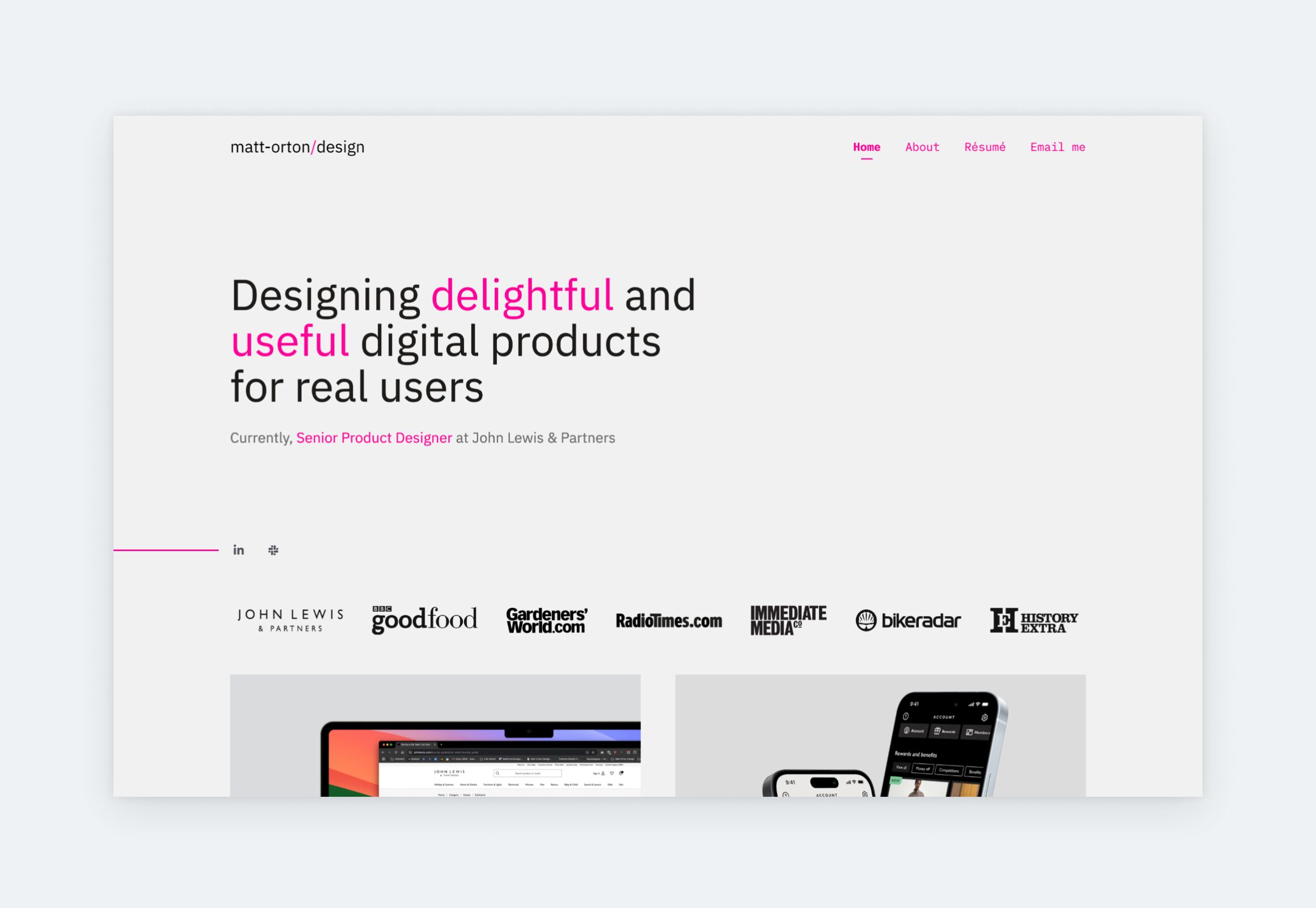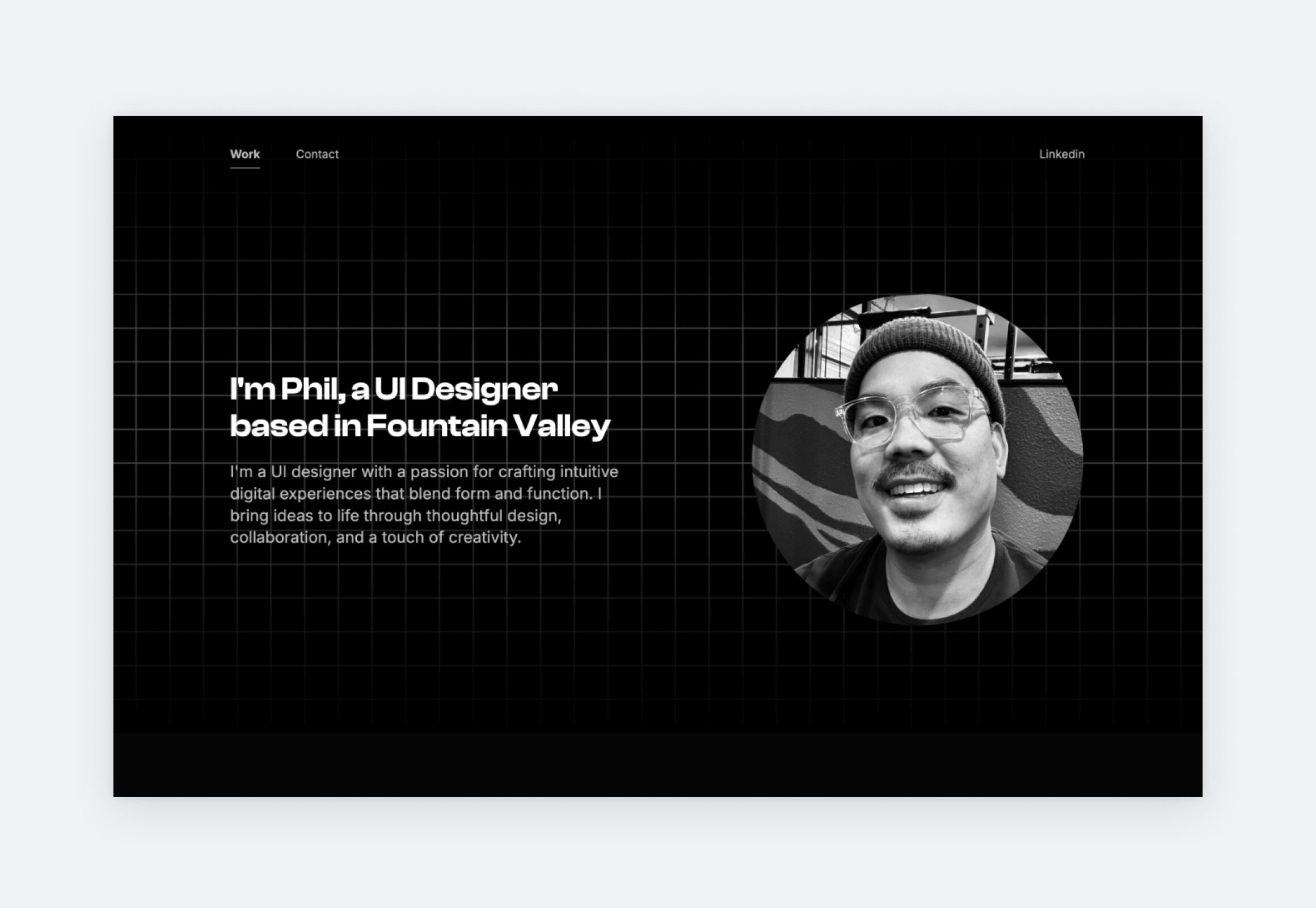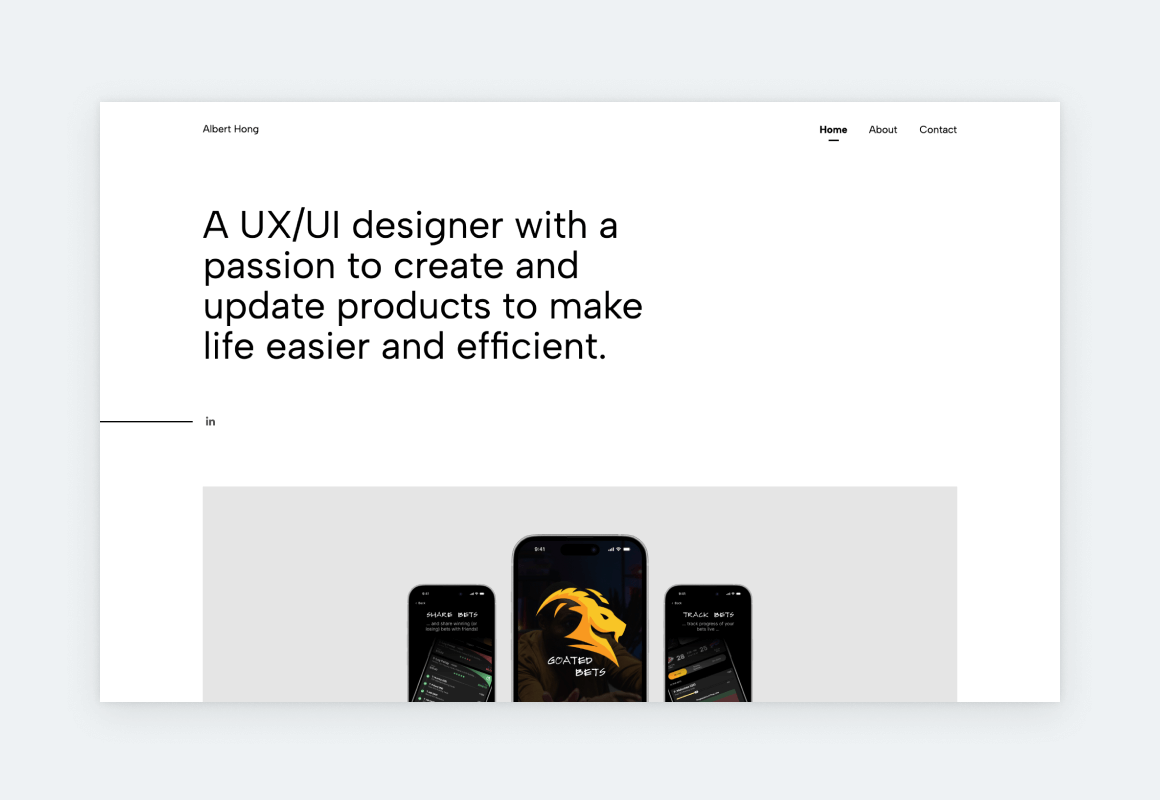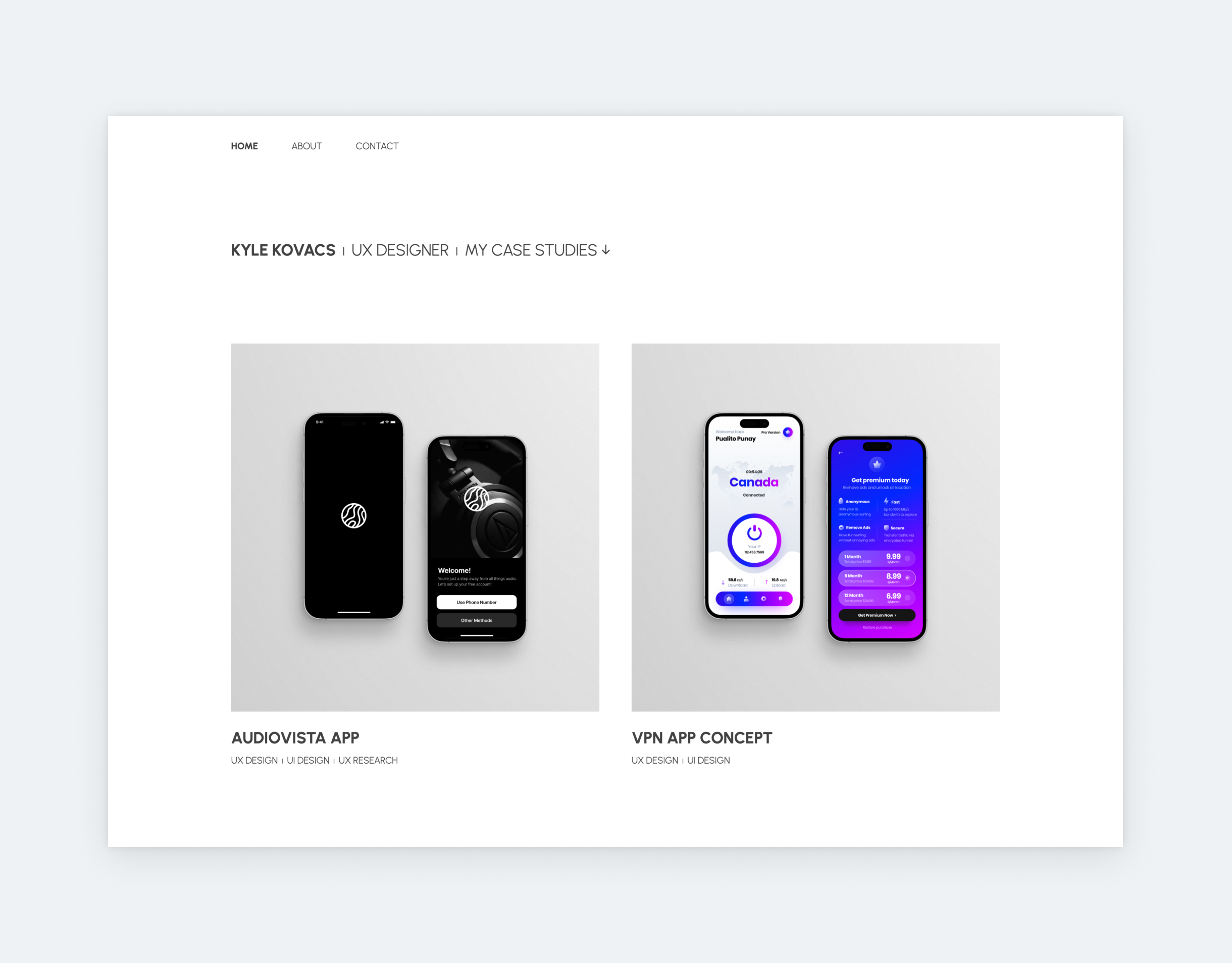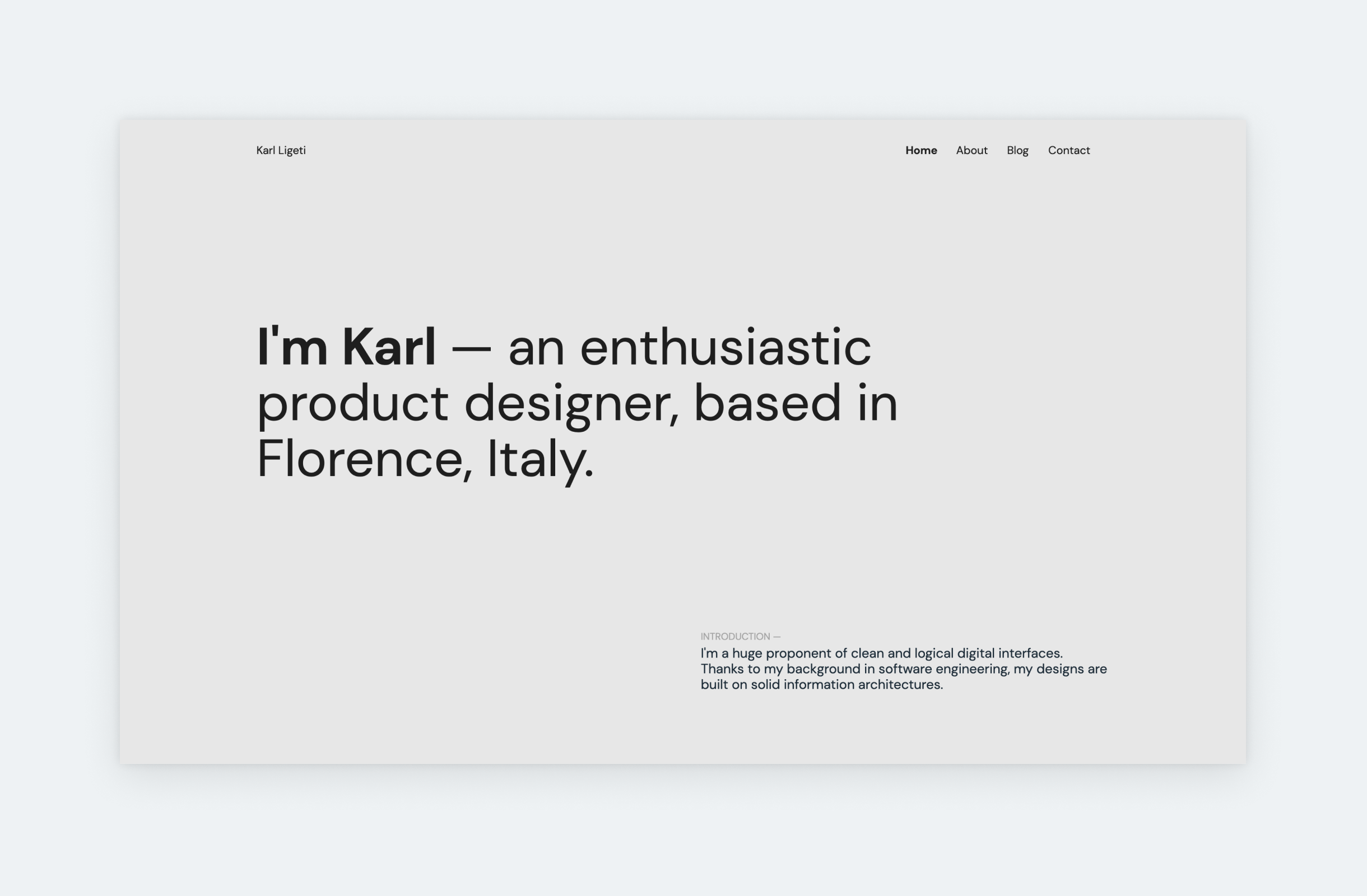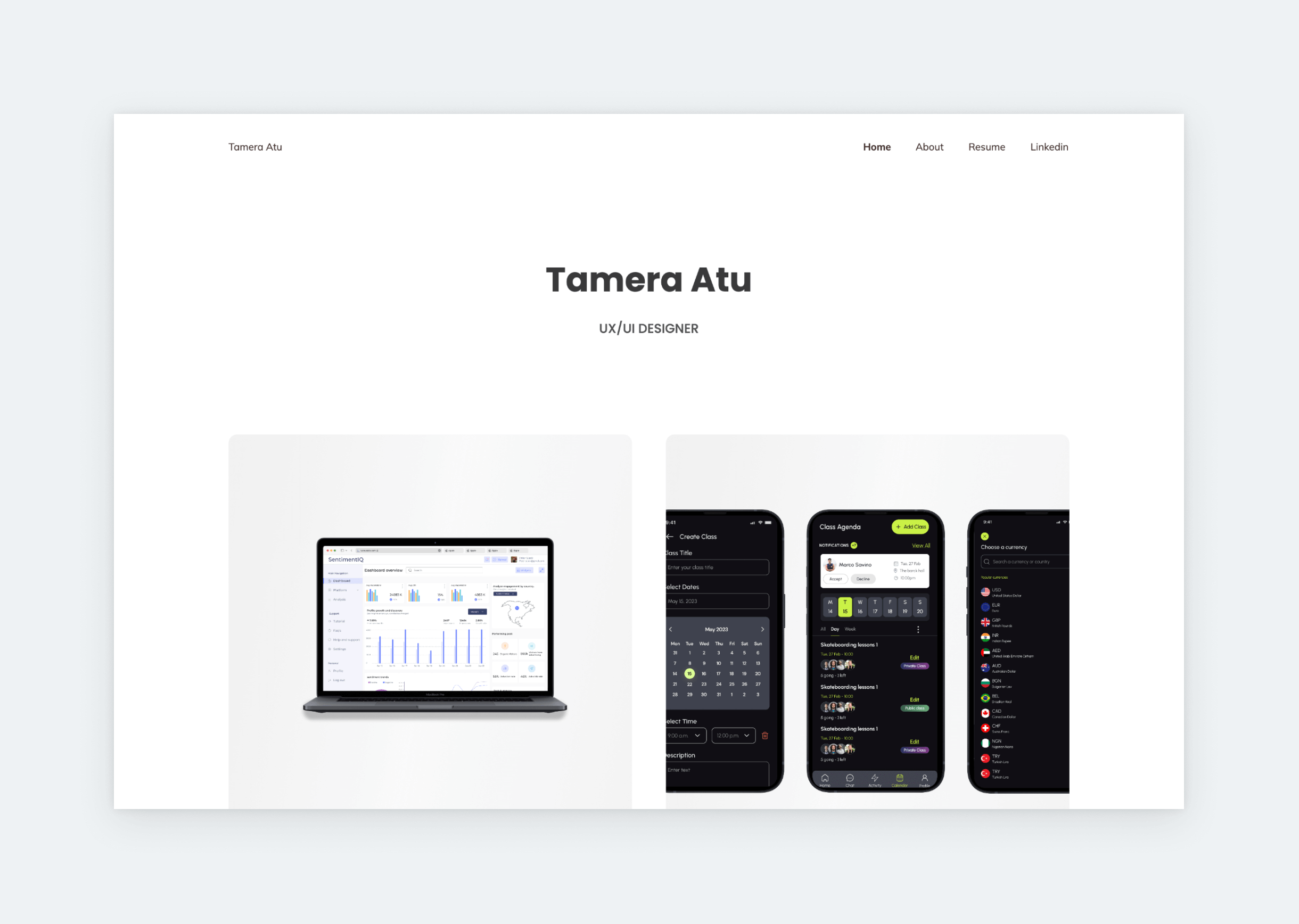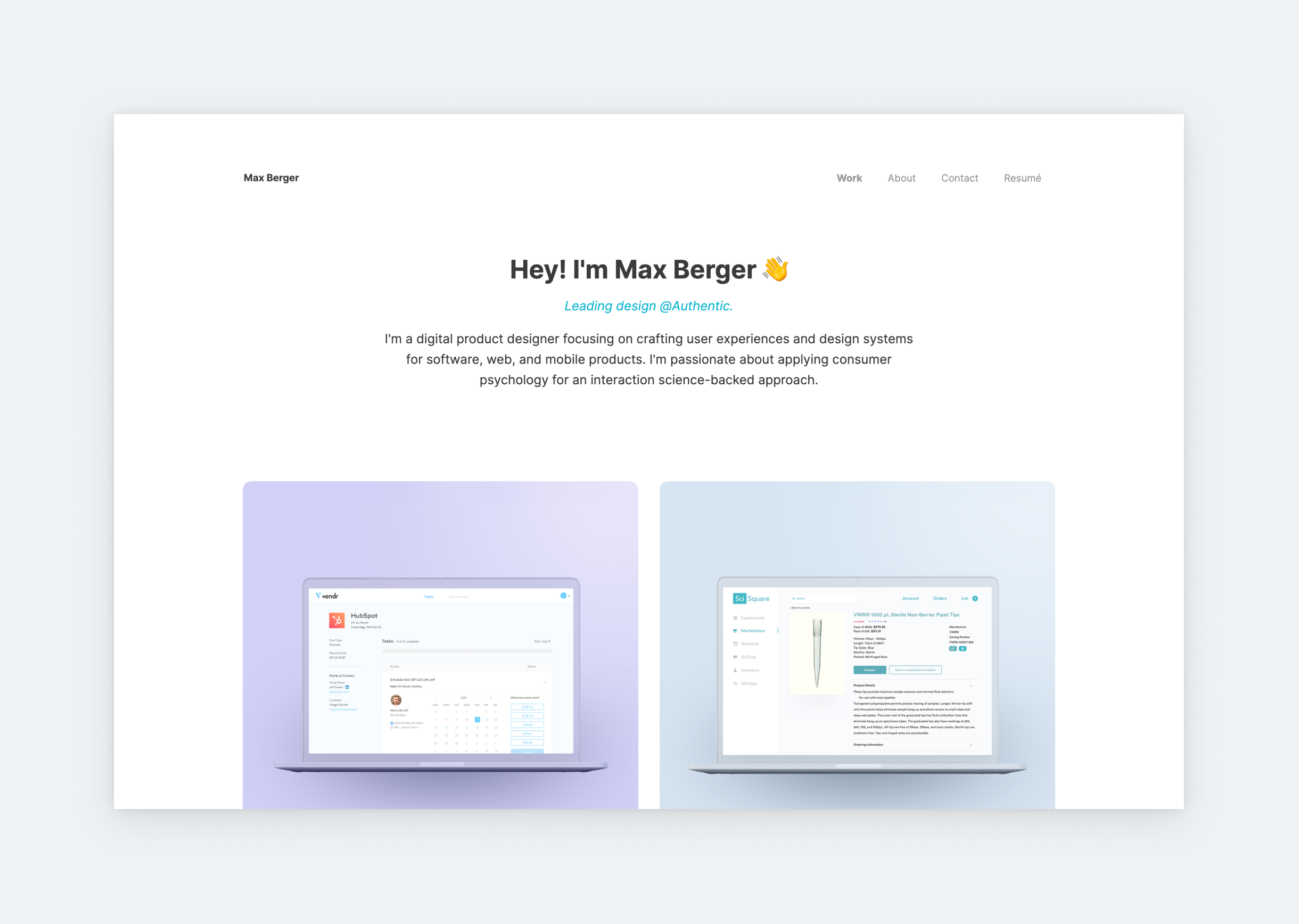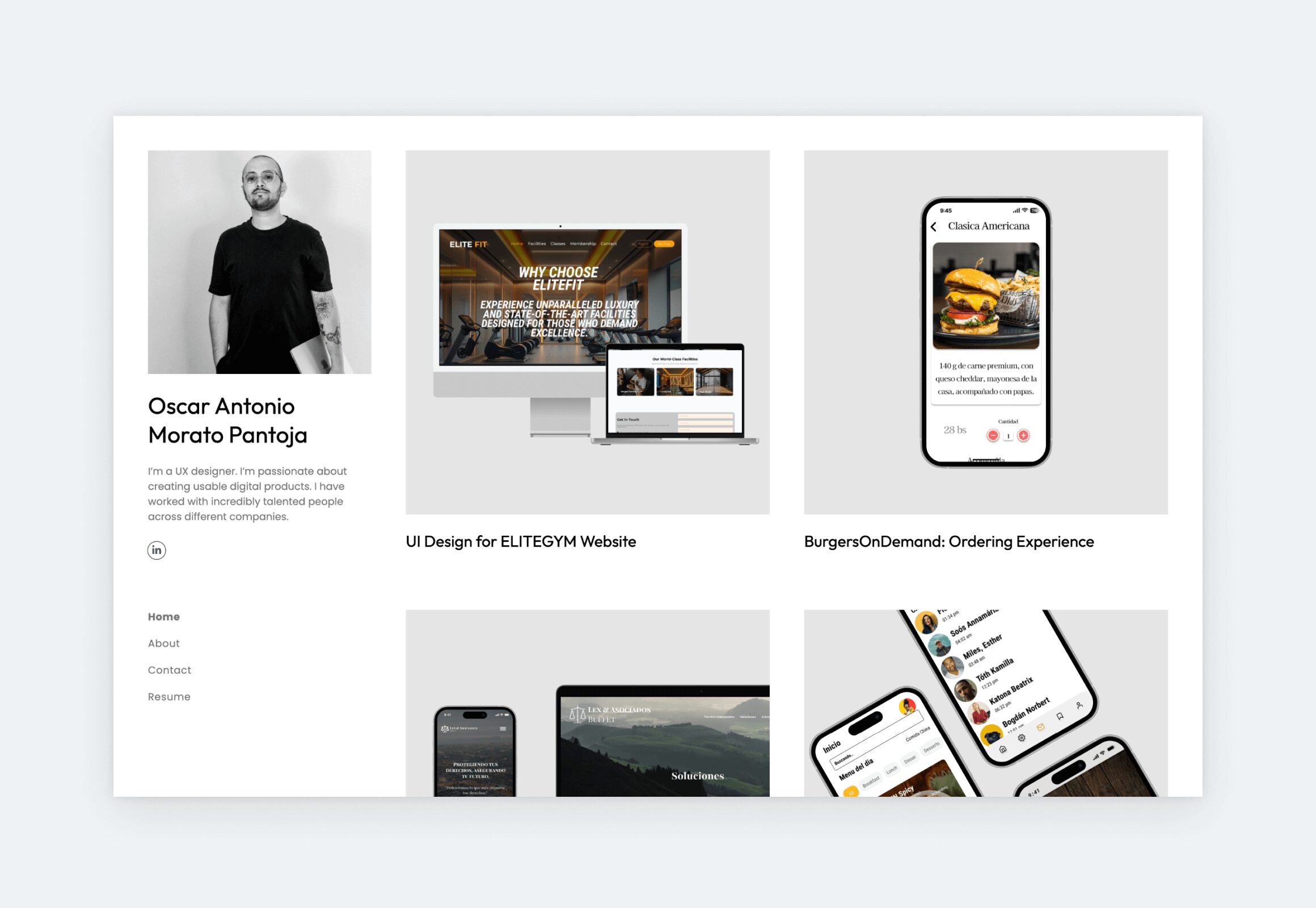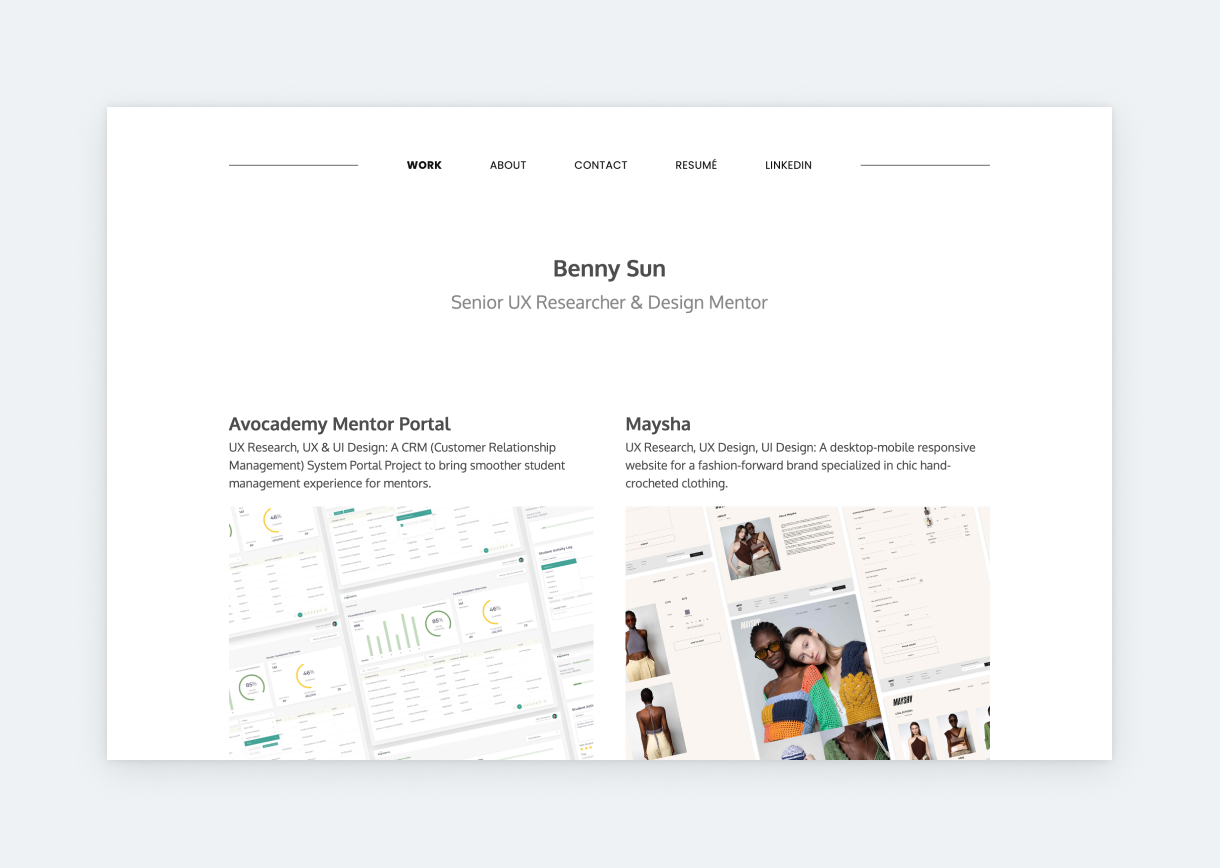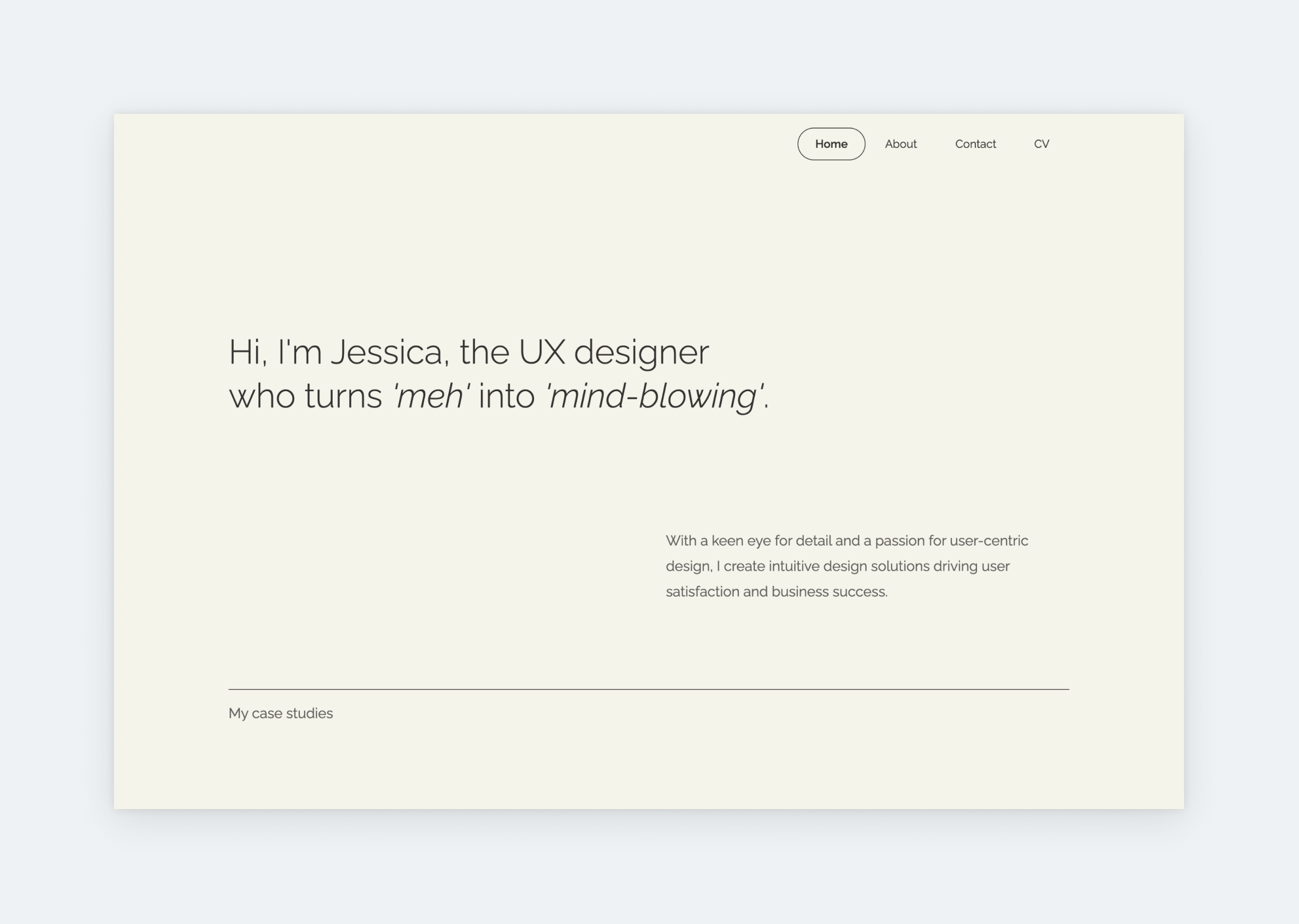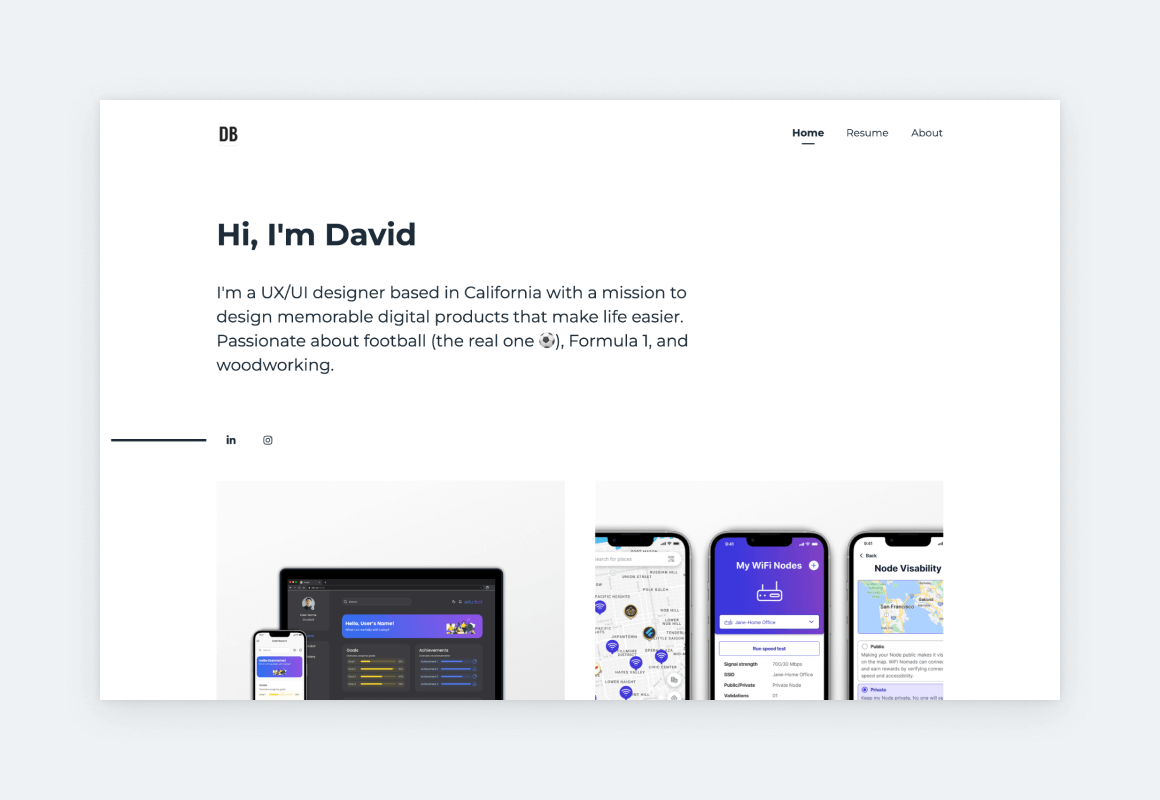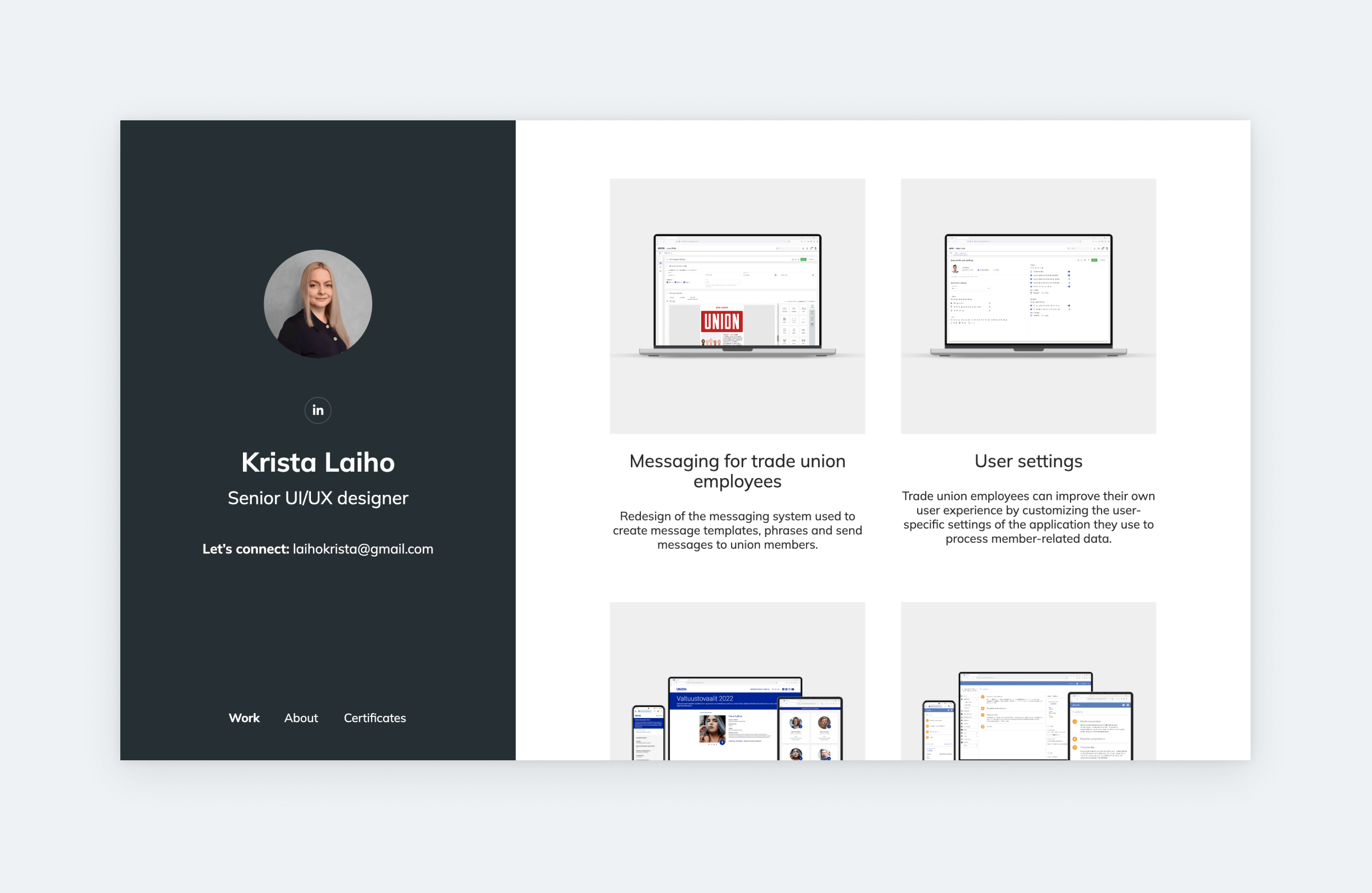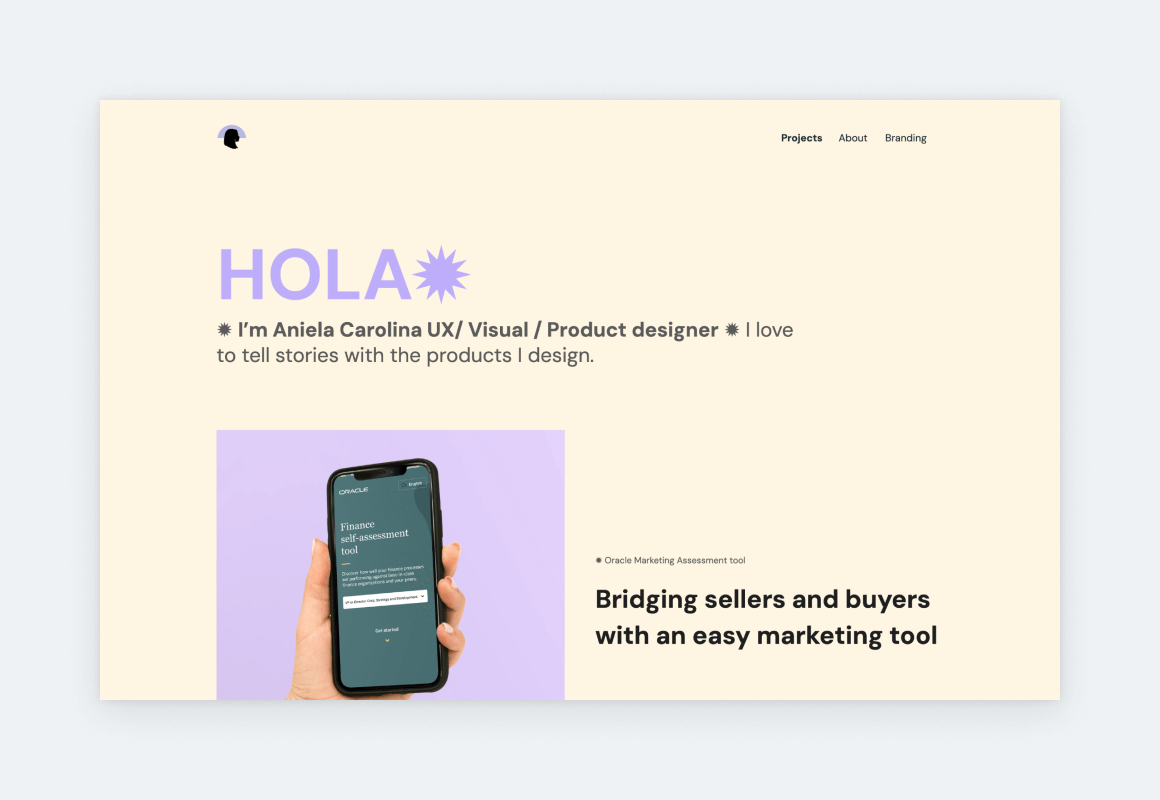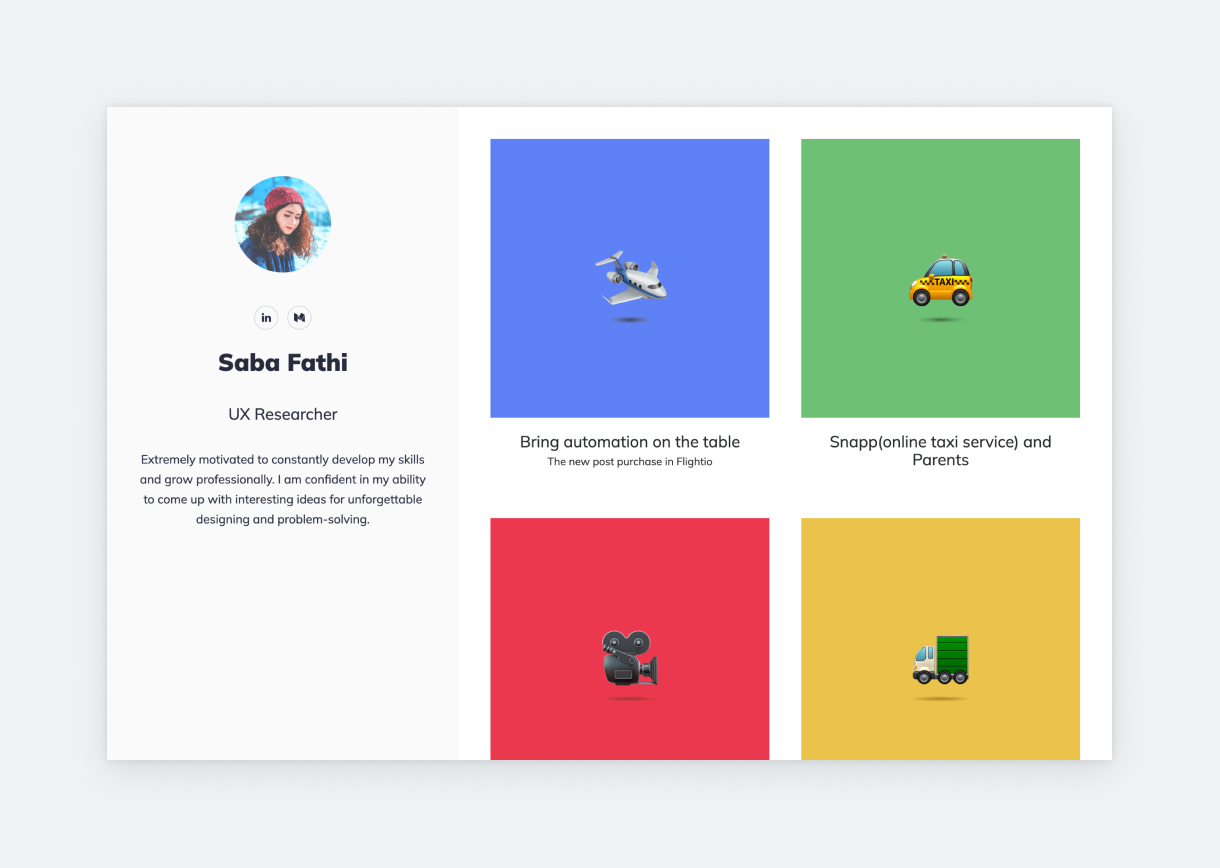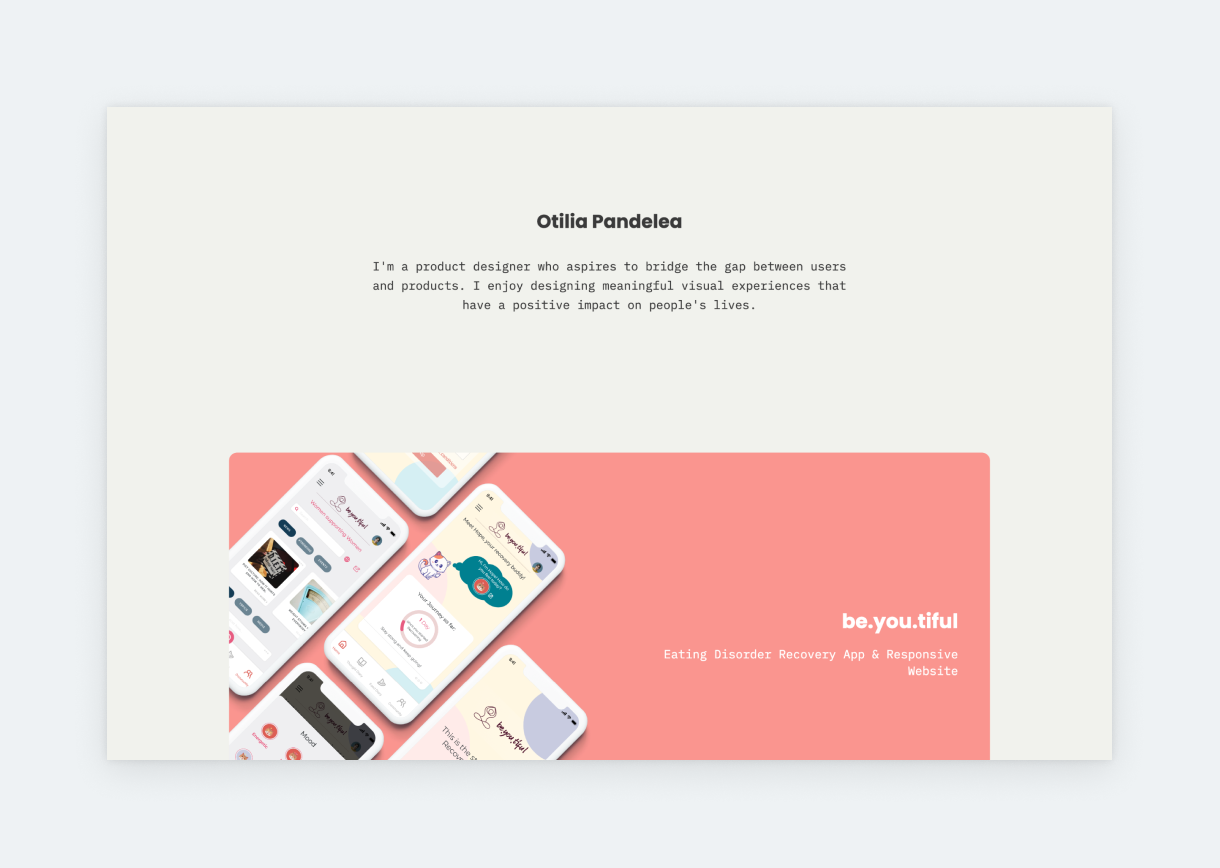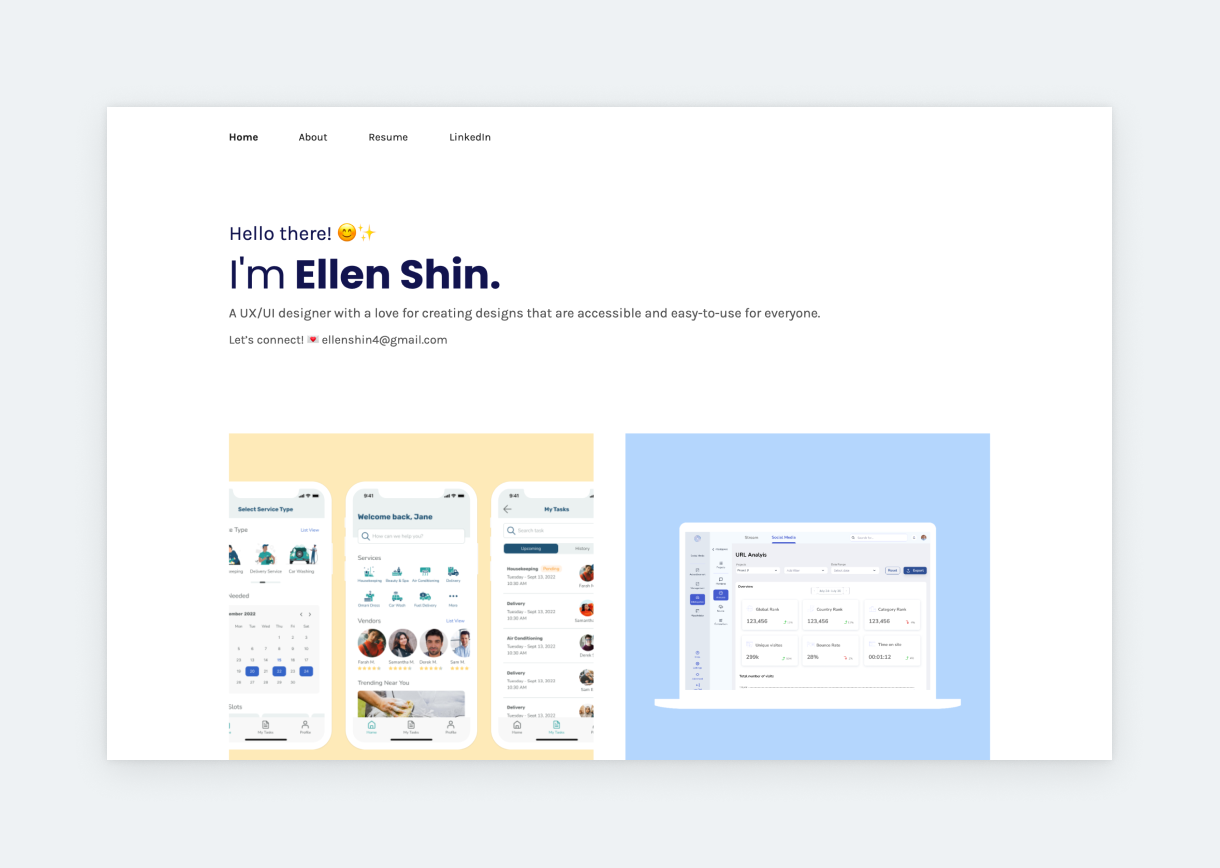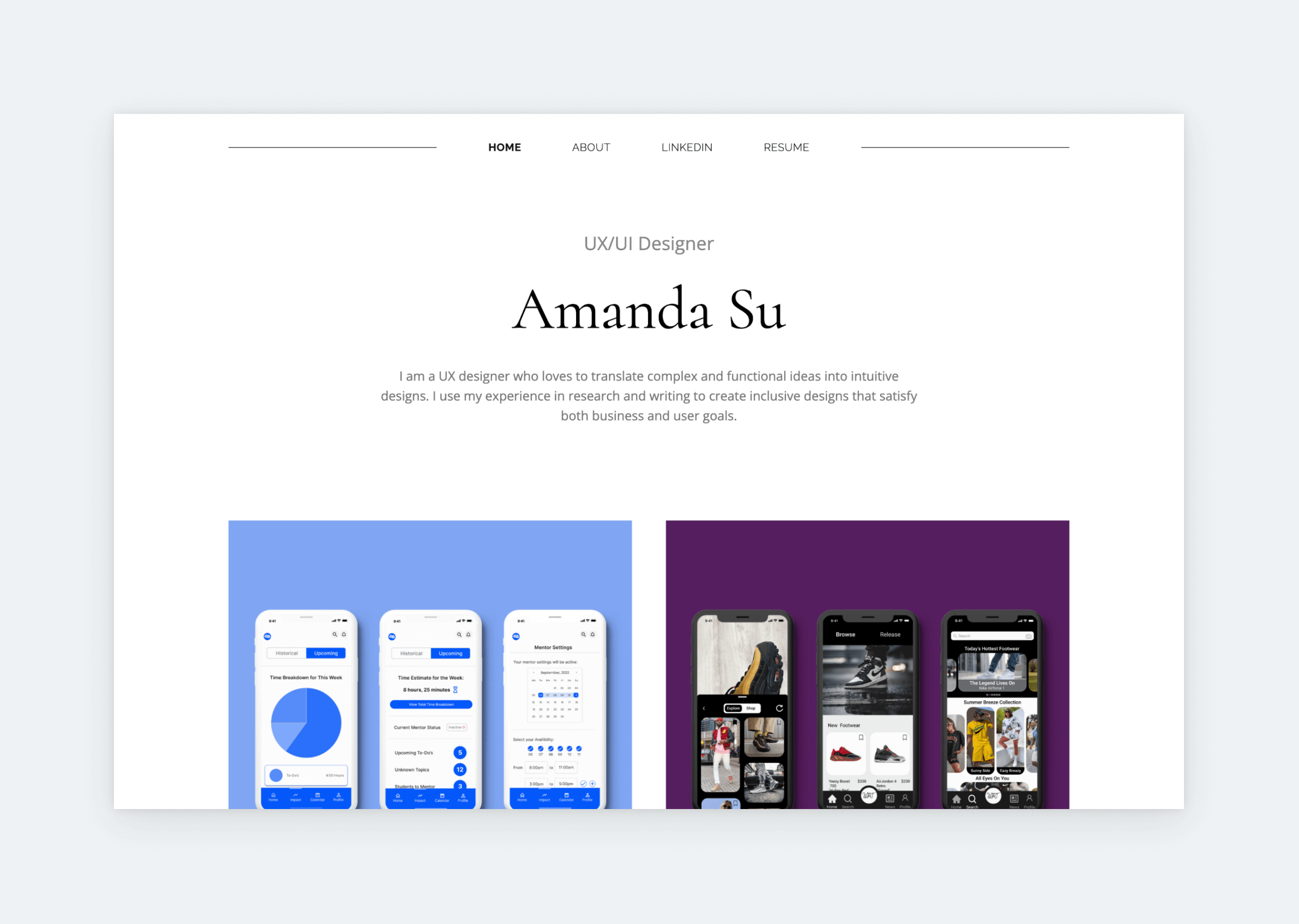Recruiters and design leads always start with portfolios when reviewing candidates. That’s why all UX designers – juniors and seniors alike – need an impressive UX portfolio. Though putting one together might seem daunting, once you get an idea of what it takes, the rest comes quickly. So, let’s get you going by checking out some of the best UX portfolio examples:
Max Marra
Max’s UX portfolio website is an impressive showcase of his skills as a UI/UX designer and lead. The prtfolio’s design is pristine and intuitive, reflecting Marra’s commitment to user-centric design principles alongside his understanding of UX portfolio best practices. His case studies span industries including fintech, e-commerce, and lifestyle apps, each following a tight structure with clear problem statements, design rationale, and measurable outcomes.
Matt Orton
Matt’s Senior UX Designer portfolio is an excellent example of strong content paired with equally strong visual design. He uses a strong pink accent color, which brings a much appreciated playfulness to this polished showcase of projects. His case study titles are thoughtfully written, demonstrating expertise through clear, descriptive phrasing, like: “Improving scalability, reusability and consistency for e-commerce app card components.”
Divya Murthy
Divya, an Experience Product Manager at HP, crafted a portfolio website that’s professional yet inviting. A muted beige backdrop sets a calm tone, while bold, custom-designed project thumbnails draw immediate attention to her projects. On the homepage, she applies smart portfolio strategy by opening with her most relevant, high-impact UX ase study: an AI project that walks through user research, wireframing, and iterative testing, culminating in a streamlined workflow solution. Her About page strikes the right balance, sharing her professional journey and personality with clarity and restraint.
Emilio Fransson
Emilio’s Senior Product Designer portfolio stands out as a strong reference for any UX designer looking to build their. His headline immediately communicates his experience level and area expertise. This is followed by descriptive case study titles and subtitles that clearly state the project type and company. The case study thumbnails are impactful and inviting, with cohesive pops of color and crisp, high-quality screens that beg to be clicked.
Phil Nguyen
Phil, UI designer at Chipotle, created a dark portfolio with minimal content outside of his projects. This is a smart way to shift our focus to his case studies, where we can see more his design through emedded Figma prototypes and screenshots. When it comes to showcasing screens, like Phil does in some of his projects, UXfolio’s built-in device mockups come extremely handy. With this feature, all you have to do is choose a device (mobile, laptop, desktop, tablet, or browser), pick a style for it (realistic, stylized, outline, etc.), and upload your screens.
Albert Hong
Albert customized his UX portfolio template using two UXfolio features: Case study grid layouts and the Thumbnail designer. The Case study grid layouts determine how case studies are arranged on the homepage. Since the grid takes up most of the landing page, changing its layout significantly alters the overall look of your portfolio. The Thumbnail designer is used to build and customize each case study’s thumbnail. You choose a layout, select a device mockup style (phone, tablet, computer, browser, realistic, stylized, etc.), and upload your screen inside. This gives you full control over how each project is presented in the grid without hassle.
Chloe Pence
Font choices speak volumes about a portfolio’s owner. In Chloe’s case, they reflect great taste. She pairs Caprasimo, a nostalgic, rounded accent font, with the modern, monospace DM Sans. It’s a bold combination that could easily clash, but here it works. That’s because both fonts share a subtle playfulness that ties the visual language together. Her case studies are extremely detailed. The first one, Nume, for example, tells a well-rounded story starting with the brief, and touching on research, defining goals, ideation, usability testing, prototypes, results, and final reflections.
Kyle Kovacs
This example shows: consistency is the key to creating a stunning UX portfolio on a tight schedule. Kyle uses the same font throughout the portfolio, adjusting only its size or weight. This results in a sleek, ultra-minimalist look. To enhance this effect, he’s also frugal with his words, letting his projects do the talking. This is in line with the newest UX portfolio trend: less-is-more style writing. Many designers add long sentences of eloquent introduction to their home page, and in most cases, it can feel awkward or uninspired. Don’t be afraid to keep it brief on your landing page! Design leads and recruiters prioritize design skills above all else. And your personality can shine on your About page, like Kyle’s.
Hana Nakano
Hana used UXfolio’s Norman template as her base, transforming it into something unique with the available customization options and features. The intense blue accent color creates an exciting contrast with the white background. Her thumbnails are in perfect harmony because she created them with UXfolio’s Thumbnail designer. This feature allows you to design professional thumbnails inside UXfolio: just bring your designs and the rest is on us! Hana’s portfolio is proof that you can create a memorable UX portfolio without overdesigning it.
Karl Ligeti
If you take a look at the best UX design portfolio examples, you’ll soon realize that the liberal use of whitespace is fundamental to all of them. Yet still, many designers – especially juniors – are frugal with it because they fear that their portfolio will look empty. If you’re unsure about whitespace, check out Karl’s portfolio: it has a minimalist design with plenty of whitespace, yet the it doesn’t look empty.
Tamera Atu
Since minimalism is always in style, you can’t go wrong with a stripped-down UX/UI portfolio, like Tamera’s. She utilized her architectural design experience to build a highly effective portfolio home page, using UXfolio’s Nominee template. The plain white background leads our attention to the pops of colors in the designs on her case study thumbnails, which is always the goal in a UX portfolio. Under the thumbnails, she writes quickfire summaries of the projects, including her role and the product profile. Like a true professional, she keeps everything short and sweet, luring you into opening a project to see more.
Max Berger
Max’s is the perfect example of what a UX portfolio should look like. Here’s why: it’s light and airy, with satisfying, pastel colors and soft, rounded corners. The UX of Max’s portfolio is also on point since the case studies are easy to reach, and the content is concise. And by making the case studies’ titles appear on hover, he didn’t compromise on the UI either. So, Max’s is a solid UX portfolio in all aspects.
Oscar Pantoja
With five years of experience, it’s clear that Oscar knows how to present his work effectively. The UX portfolio template he chose skips a hero section and puts his case studies front and center. This choice reflects a strong understanding of his audience: recruiters, design leads, and others who want to get straight to the work. Featuring six UX case studies feels right for his level of experience: substantial without being too overwhelming. His project thumbnails were created with UXfolio’s Thumbnail designer, which explains their consistent, professional look.
Adrian Weber
Look no further for a portfolio to use as a basis for yours. Roland’s portfolio conforms to all UX portfolio best practices: only the basics in his hero section, 3 of the most important pages in the navigation, and 2 case studies presented by matching thumbnails. It’s effortless, usable, and elegant.
Benny Sun
Benny’s portfolio is clean and professional. He saves his introduction to his About page to pull our attention toward the projects. That’s how we know we’re looking at a senior UXer’s portfolio. Experienced designers know that in UX, case studies get you the job. The reason is simple: case studies showcase your UX skills and process in action, underpinned with examples. Therefore, as our research revealed, most design leads go for case studies right away when opening a portfolio. Benny understands this, and he crafted this stunning, consistent portfolio accordingly.
Jessica
The right template with the right typography is all you need for a stunning UX design portfolio. The cream background of Jessica’s portfolio is in perfect harmony with the elegant, thin Raleway font she chose. Scrolling down, you’ll see harmonized case study thumbnails that she created with UXfolio’s Thumbnail designer. The outcome is just amazing. As soon as you land on this portfolio, you know that you can relax because its creator knows what she’s doing. This sense of relief is very important when it comes to landing a job, and it’s best achieved by following 5 simple guidelines: soothing color palette, consistent typography, brief copy, abundant whitespace, and coordinated visuals.
Rebeca Gordo
Combining neon colors with dark shades results in a modern and stylish look. But only if you hit the right balance with the neon, as it can turn obnoxious very easily. The best way around this is to use the neon as an accent, instead of a primary color, like Rebeca did in her UX/UI portfolio. As you can see, she used it to highlight some of her text, while keeping the rest of her portfolio, including her UX/UI case study thumbnails, easy on the eye. Don’t forget, that a solid dark background color – like Rebeca’s – is just as universal as a simple white background, however, it lends an effortless edge to the portfolio’s vibe. If it fits your personality, give it a try!
Rachel Baek
Rachel B is a UX designer and researcher who translates academic research into user-friendly products. Rachel’s portfolio is easy on the eye with its refined design and a comforting color scheme that reflects her personality and style. She follows UX portfolio best practices by using a consistent layout and clear navigation through and through. Her UX case studies highlight her hard skills, such as UX research, wireframing, and prototyping, as well as her soft skills, such as communication and collaboration. Rachel’s portfolio is a great example of how to portray, promote, and showcase a wide range of design skills in a captivating manner.
David Bornfirend
David’s UX portfolio website is a masterclass in clean and modern design. The homepage is pure yet attention-grabbing thanks to the large headline that sets the tone for the rest of the website. This direction, combined with the black-white-gray color palette, underlines David’s professionalism also apparent from his well-structured and stunning case studies, in which he achieves the perfect balance between copy and visuals.
Krista Laiho
Krista is a senior UI/UX designer with nearly ten years of experience, which is clearly reflected in her portfolio. She uses a UX portfolio template with a sidebar, which calls for a specific approach to ensure that her visitors’ attention is on her projects. This involves keeping the intro on the right side brief and eliminating unnecessary design elements, so as to not steal the attention from the project grid on the other side of the screen. Krista included a portrait of herself right on the home page, which is usually advised against. However, in her case, it elevates the overall impression because it looks professionally done. Finally, she coordinated her project covers perfectly by using the same device mockup styles and colors, achieving an uber-polished effect.
Aniela Carolina
Aniela has been a designer for 10 years and her experience is obvious from the way she presents herself and her work. First of all, she chose a lovely accent color and applied it consistently throughout various elements of her pages. Furthermore, she uses icons and typography to create a sharp content hierarchy. The longer case study titles on her home page act as super-descriptive snippets into the projects. She included 3 projects in her portfolio, yet, as you scroll through her home page, it feels and looks more because of the project grid she chose in UXfolio’s editor.
Alyssa Ignacio
If you’re looking for the perfect, non-cliché designer statement, check out Alyssa’s: “Making a positive impact on my communities through collaboration, empathy, and endless funfetti cookies.” As simple as it is, this intro – mixed with the warm tones of her portfolio – makes her instantly likable. She keeps to this much-welcome conciseness throughout the portfolio. Though the whole UX/UI portfolio looks amazing, we’d like to highlight the type she used for the descriptions on her thumbnails: it’s small, stylish, yet still readable. Many designers are afraid of small font sizes, but with the right type, going small can create a chic effect without affecting usability or accessibility.
Julia Lauren
The best word to describe Julia’s portfolio is “cozy”. There’s something about a beige color palette that’s immediately comforting. These vibes are further strengthened by her portrait, which shows her with a beautiful, welcoming style. The only time you should feature your portrait as prominently on your home page as Julia does, is if you have a professional portrait that matches the color palette of your portfolio. Otherwise, it results in a tacky, resume-ish look, that’s not ideal for a designer. The rest of Julia’s portfolio is also exemplary. Take for example, how she ties her case study thumbnails together by using matching, soft gradients for their backgrounds.
Saba Fathi
We hear many stories of researchers struggling with their UX research portfolio. Saba shows you how to tackle this challenge. Instead of going with the usual serious look, she created a playful portfolio, using bright colors and a handful of matching emojis. Emphasis on matching. This look works for Saba because the emojis on her project thumbnails are from the same source, and the colors she uses on her backgrounds are in perfect harmony.
Otilia Pandelea
Otilia made her portfolio unique by using a stunning font pairing: Poppins with IBM Plex Mono. This pairing and the harmonious color story look wonderful throughout the entire portfolio. Her about page, with custom graphics, is another highlight. We love the two lists: one about her goals and another about her frustrations. It’s new. It’s fresh. Also, the two lists balance each other perfectly and make us feel in tune with her.
Ellen Shin
With positive emojis in her bio and colorful project thumbnails, Ellen brings warmness to this otherwise strict and minimal template. By using large typography under her thumbnails, she drives attention to the copy, which describes each project in a concise style. Ellen’s Neurotime case study is also featured on our showcase since it’s the textbook example of how it should be done: clear structure, plenty of visuals, and descriptive but not overlong. She uses UXfolio’s built-in device mockups to present her examples, ensuring that the case study looks visually consistent.
Amanda Su
It’s rarer and rarer to find serif fonts in UX design portfolios. Amanda doesn’t feature them heavily either, but she found a way to include a stunning one – Cormorant – in her hero section in a very tasteful way: using it only for her name and matching it with a simple sans serif font. This creates a sleek, slightly serious, and very professional look that’s underpinned by the rest of her portfolio’s aesthetic choices, such as the solid-color thumbnail backgrounds. She did an excellent job with the case study titles as well, as they provide concise yet intriguing descriptions about the products in question.
What is a UX portfolio?
A UX portfolio is a website or document made for hiring managers and design leads, showcasing how you create value through design by turning ambiguity, user needs, and business goals into measurable outcomes. It contains UX case studies that demonstrates your problem-solving skills, how you make and communicate decisions, and how you collaborate.
While many treat it as a visual gallery, standout portfolios function as a decision narrative that makes your thinking visible and your impact undeniable.
How to create decision narratives?
In an impactful UX portfolio every section or chapter (research, wireframes, testing, iteration, etc.) should trace a clear line from signal to decision and results:
- What data did you collect?
- What friction did you observe?
- What decisions did you make?
- What constraint changed your direction?
- And what was the result of your decision?
Decision narratives tell reviewers you’re not just following trends or ticking UX boxes. You’re weighing trade-offs, working with uncertainty, and aligning design with measurable outcomes.
Why most UX portfolios fail?
Most articles define a portfolio as a visual showcase, which is only partially true. Yes, your portfolio should look good and it should contain lots of visuals to aid comprehension. However, visuals should never take priority over decision narratives and storytelling. Otherwise, your portfolio cannot fulfil its purpose, which is to help hiring managers learn about
- your process under pressure,
- your collaboration style, and
- how repeatable your success is.
And this leads to rejection.
What a UX portfolio needs to show
Decision-makers skim portfolios under time pressure. So you have limited time to make a positive impression you yours should include:
- 3 to 4 detailed case studies
- Your exact role and scope
- Design decisions and iteration
- Impact metrics
- Reflection
At its best, your portfolio becomes a mirror of how you operate in real-world projects.
Takeaways from the best UX portfolios
Now that you’ve seen some of the best UX portfolios out there and learned what makes an impactful portfolio, you’ve probably realized that there seems to be a UX portfolio formula: a structure which the industry is familiar and comfortable with. Let’s take a deeper look at this:
Home page
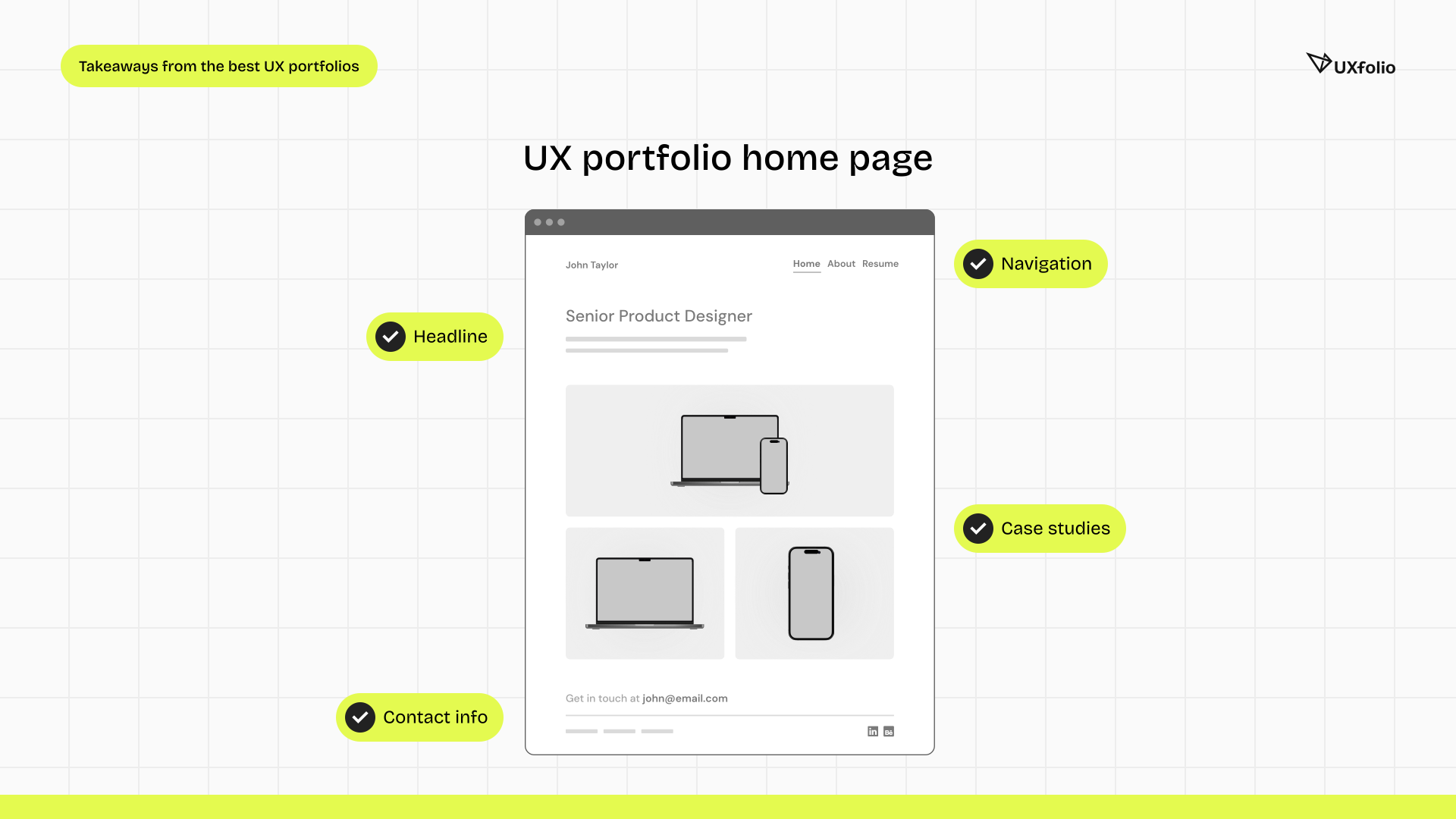
Your home page is your visitors’ first touchpoint with your portfolio, the first impression you make. Therefore, it has to
- look great -> so your visitors want to see more.
- help with orientation -> make it easy for them to see more.
Content on your home page:
- Name,
- Occupation/title,
- Designer statement/headline,
- Links/thumbnails to case studies,
- Navigation (to various pages, like About me, Resume, and Contact).
Case study thumbnails
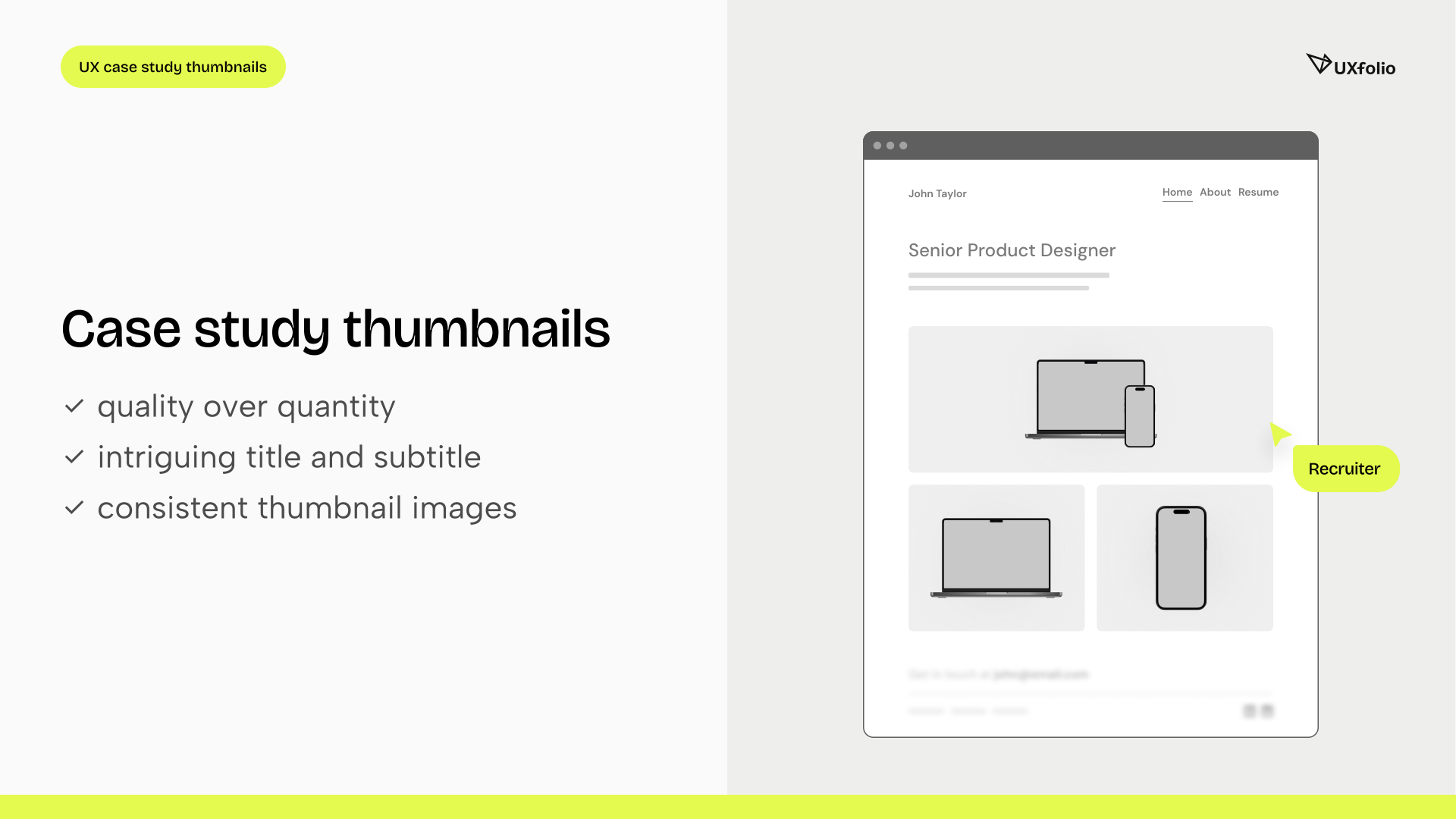
All things considered, your thumbnails are the most important part of your portfolio’s home page. Even more important than your navigation, for example: if you think about it, the point of a portfolio is to showcase your skills and process through case studies. Therefore, you need to get your visitors to open your case studies. The best way to do this is by creating enticing case study thumbnails and featuring them right on your home page.
The 5 golden rules of case study thumbnails:
- Write a descriptive titles and subtitles for your case studies.
- Make sure that the thumbnails look good individually and as a group.
- Use the same device mockup style for every thumbnail.
- Make sure that the thumbnails’ backgrounds harmonize.
- The thumbnails have to match the vibe of the home page (not the inside of the case study).
UX case studies
We all know that UX goes beyond pretty screens. Therefore it’s understandable that UX leads and recruiters want to see your approach and process. And through case studies, you can show it to them. Great case studies combine the following ingredients:
- Logical thought processes.
- Skills, both hard and soft, including
- Communication,
- Teamwork,
- Ability to work independently,
- Decision-making based on research and data,
- Ability to learn from mistakes, and
- Problem-solving.
- Design process.
- Knowledge of UX methods and their application.
- Openness to feedback.
- Desire to improve.
Nice-to-haves in a UX portfolio
While your home page and case studies are the most important elements of your portfolio, you should take it a step further. Adding pages like About/Bio, Contact, UX designer resume, and social links can make your portfolio more usable, revealing, and personal.
How to showcase skills in your UX portfolio?
Our job at UXfolio includes talking to world-renowned design leaders to find out what they’re looking for in portfolios. We had to pleasure of talking to some of the most innovative and influential UX designers in the industry, such as
- Design Spring inventor Jake Knapp,
- behavioral scientist Susan Weinschenk,
- UX industry veteran Jared Spool, and
- InVision lead designer Pablo Stanley.
They all mentioned that the best UX portfolios show the design process and decisions. Of course the final design is important too, but they want to see how you’ve arrived there. They want you to explain your decisions and to tell why you decided to go with those specific solutions.You need to share design stories. Present your design process step-by-step, from the beginning to the end.
Tell your design story with UXfolio!
In case you need a tool to help build your portfolio quickly and easily, we made a great one: UXfolio. We created it specifically for UX professionals, so it’s packed with powerful features that’ll help you through the portfolio-building process. These features include text ideas and guiding questions for copywriting, prototype embedding, scrollable mockups, galleries, statistics section and many, many more. Give it a try!
